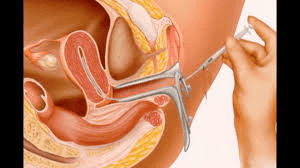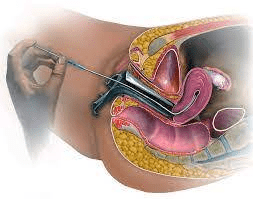Often times, ruminant farmers always want to know which method is better between natural mating and artificial insemination. Well, if the semen to be used in Artificial Insemination are well preserved and handled, it could be better because a single ejaculate can be used to mate as much as 20 or more females while in natural mating, it is a male to a female at a time.
What is artificial insemination and why would a livestock producer want to AI his breeding stock?
Artificial insemination (AI) is the process of collecting sperm cells from a male animal and manually depositing them into the reproductive tract of a female.
Artificial insemination is commonly used instead of natural mating in many species of animals because of the many benefits it can reap. These benefits include increased safety of the animals and producer, increased production efficiency and better genetics.
Artificial insemination can reduce many of the risks involved with breeding. Natural mating is a stressful process that has a much higher tendency to result in injuries or accidents of both the animals and producer. Particularly in cattle, males tend to be very large and sometimes aggressive.
Artificial insemination removes all risks involved with keeping a male on the premise. Furthermore, artificial insemination reduces the risk of transmitting diseases.
The entire artificial insemination procedure is much more hygienic than natural mating. All the tools and equipment are sterilized both before and after. The entire procedure is altogether a much cleaner and sanitary process.
Artificial insemination also increases efficiency. Most males usually produce enough sperm in a single ejaculate to be diluted and extended enough to create over one hundred doses. For some species, diluted semen is then packaged into “straws” and frozen. These straws of frozen semen are typically stored in a nitrogen tank where they will last for years and can be used as needed.
The semen can also be shipped to various livestock producers around the United States, allowing them to artificially inseminate their herds. This gives many producers the opportunity to avoid keeping a male on the farm or potentially having to take their breeding animals to a male.
Lastly, artificial insemination can drastically improve the genetics of your herd. With artificial insemination becoming increasingly popular, many producers collect semen from their herd sires and make it available to other producers for purchase.
This gives producers the opportunity to select what they want to breed their animals to. Proven and better genetics are becoming readily more available across the nation, and the quality of livestock in the Unites States continues to increase.
Also the fertility rate is higher with Artificial Insemination (A.I) than with Natural Mating because in Artificial Insemination (A.I) one is also 100% sure that the semen has been introduced into the proper place whereas in Natural Mating, it is possible for mating to occur without fertilization because the semen may be having problem or may not have been introduced into the proper place in the female.
Moreover, Artificial Insemination (A.I) could be economical when the number of female that can be fertilized with a single ejaculate is considered.
However, when the details involved in Artificial Insemination (A.I) like preserving the semen and expertise in introducing the semen is considered, then, natural mating may be preferred especially by those who could not afford the cost of transportation of semen and those of preserving them.
Artificial insemination is the technique in which semen with living sperms is collected from the male and introduced into female reproductive tract at proper time with the help of instruments.
This has been found to result in a normal offspring. In this process, the semen is inseminated into the female by placing a portion of it either in a collected or diluted form into the cervix or uterus by mechanical methods at the proper time and under most hygienic conditions.
The first scientific research in artificial insemination of domestic animals was performed on dogs in 1780 by the Italian scientist, Lazanno Spalbanzani. His experiments proved that the fertilizing power reside in the spermatozoa and not in the liquid portion of semen.
Artificial insemination is not merely a novel method of bringing about impregnation in females. Instead, it is a powerful tool mostly employed for livestock improvement.
In artificial insemination the germplasm of the bulls of superior quality can be effectively utilized with the least regard for their location in far away places.
By adoption of artificial insemination, there would be considerable reduction in both genital and non-genital diseases in the farm stock.
Read Also: Find out which of the Ruminant Breeds is better to raise
Pros of Artificial Insemination over Natural Mating

There are several advantages by artificial insemination over natural mating or servicing.
- There is no need of maintenance of breeding bull for a herd; hence the cost of maintenance of breeding bull is saved.
- It prevents the spread of certain diseases and sterility due to genital diseases.
- Eg: contagious abortion, vibriosis.
- By regular examination of semen after collection and frequent checking on fertility make early detection of interior males and better breeding efficiency is ensured.
- The progeny testing can be done at an early age.
- The semen of a desired size can be used even after the death of that particular sire.
- The semen collected can be taken to the urban areas or rural areas for insemination.
- 7 It makes possible the mating of animals with great differences in size without injury to either of the animal.
- It is helpful to inseminate the animals that are refuse to stands or accept the male at the time of oestrum.
- It helps in maintaining the accurate breeding and cawing records.
- It increases the rate of conception.
- It helps in better record keeping.
- Old, heavy and injured sires can be used.
Disadvantages of Artificial Insemination over Natural Mating
- Requires well-trained operations and special equipment.
- Requires more time than natural services.
- Necessitates the knowledge of the structure and function of reproduction on the part of operator.
- Improper cleaning of instruments and in sanitary conditions may lead to lower fertility.
- If the bull is not properly tested, the spreading of genital diseases will be increased.
- Market for bulls will be reduced, while that for superior bull is increased.
Read Also: Measures of Improving Field Crops Production
A practical recommendation for timing of artificial insemination (A.I) over Natural Mating;
| Cows showing estrus | Should be inseminated | Tool late for good results |
| In morning | Same day | Next day |
| In afternoon | Morning of next day or early afternoon | After 3 p.m. |
Artificial Insemination Techniques

The technique of inseminating a cow is a skill requiring adequate knowledge, experience and patience. Improper AI techniques can negate all other efforts to obtain conception.
Semen must be deposited within the tract of the cow at the best location and at the best time to obtain acceptable conception rates. Early methods of AI involved deposition of the semen in the vagina, as would occur in natural mating. Those methods are not satisfactory.
Fertility is low and greater numbers of sperm are required. Another method which gained popularity was the “speculum” method. This method is easily learned, but proper cleaning and sterilizing of the equipment is necessary, making it more impractical to inseminate than with the rectovaginal technique which is the most widely used AI method today.
In the recto-vaginal technique a sterile, disposable catheter containing the thawed semen is inserted into the vagina and then guided into the cervix by means of a gloved hand in the rectum.
The inseminating catheter is passed through the spiral folds of the cow’s cervix into the uterus. Part of the semen is deposited just inside the uterus and the remainder in the cervix as the catheter is withdrawn.
Expulsion of the semen should be accomplished slowly and deliberately to avoid excessive sperm losses in the catheter. The body of the uterus is short; therefore, care should be taken not to penetrate too deeply which might cause physical injury.
In animals previously inseminated, the catheter should not be forced through the cervix since pregnancy is a possibility. Since research data show little variation in conception rates when semen is placed in the cervix, uterine body or uterine horns, some people recommend incomplete penetration of the cervical canal and deposition of semen in the cervix.
The recto-vaginal technique is more difficult to learn and practice is essential for acceptable proficiency but the advantages make this method of insemination more desirable than other known methods.
With practice, the skillful technician soon learns to thread the cervix over the catheter with ease. If disposable catheters are used and proper sanitation measures are followed, there is little chance of infection being carried from one cow to another.
Timing of Artificial Insemination over Natural Mating for Maximum Conception
A frequent question concerning AI is: What time during estrus should cows be bred for greatest chance of conception? Since estrus may last from 10 to 25 hours there is considerable latitude in possible time of insemination. Much research work has been conducted on this subject.
Controlled investigations were conducted by Trim Berger and Davis at Nebraska in 1943. These and other studies show that conception rate is lower when cows are bred prior to mid estrus or later than 6 hours after cessation of estrus (standing heat in this case).
Maximal conception is obtained when cows are inseminated between mid estrus and the end of standing estrus, with good results up to 6 hours after estrus.
Success in insemination timing is dependent upon a good heat detection program. In large herds, this means assigning individual responsibility for heat detection and a continued education program for labor.
A successful heat detection program and subsequent proper timing of insemination will pay dividends in increasing reproductive efficiency.
Read Also: How to Raise Ruminant Animals for Fattening and Reproduction together
Symptoms of Heat
The various symptoms of heat are;
- The animal will be excited condition. The animal will be in restlessness and nervousness.
- The animal will be bellow frequency.
- The animal will reduce the intake of feed.
- Peculiar movement of limbo sacral region will b observed.
- The animals which are in heat will lick other animals and smelling other animals.
- The animals will try to mount other animals
- The animals will standstill when other animal try to mount.. This period is known as standing heat. This extends 14-16 hours.
- Frequent maturation (urination) will be observed.
- Clear mucous discharge will be seen from the vulva, sometimes it will be string like the mucous will be seen stick to the near the pasts of valva.
- Swelling of the valva will be seen.
- 11 Congestion and hyperemia of membrane.
- The tail will be in raised position.
- Milk production will be slightly decreased.
- On Palpation uterus will be turgid and the cervix will be opened.

Thanks for your encouragement and sharing